Tuesday 16th May 2023

In what’s describe as a “world first”, Stagecoach began operating the much hyped and long awaited autonomous bus trial across the Forth Road Bridge yesterday. And if you’re thinking that “world first” claim rings a bell – you’re not mistaken as it was just over two months ago I reported on another “world first” autonomous bus trial involving First Bus in Didcot and nearby Milton Park.
What is it with this childish corporate obsession of having to always be a “world first” anyway? When you read the small print on the Government’s website hailing the Stagecoach trial it actually qualifies the claim as being “the world’s first full-sized, self-driving bus service” presumably because size means everything on these corporate ego trips, and the First Bus trial only managed to muster a measly Mellor minibus sized vehicle.
Anyway, this is all irrelevant to the main topic in hand …. yet more technology that’s set to revolutionise bus travel; or maybe not.

The UK Government website report dated September 2020 explains CAVForth (the project name) “expects to be carrying passengers by this time next year” so only 20 months behind schedule which I suppose isn’t too bad considering the technological development involved and the number of partners on board.

CAVForth is a joint project of Fusion Processing, Stagecoach, Alexander Dennis, Transport Scotland, Edinburgh Napier University and Bristol Robotics Lab with part funding from the UK Government’s Centre for Connected and Autonomous Vehicles.
You need a full sized bus if only to accommodate all those logos.

Five Alexander Dennis Enviro200AV vehicles have been fitted out with Fusion Processing’s CAVStar control and sensing system integrated with the steering, throttle and braking systems. This enables them to operate at what’s called AV Level 4 autonomy (meaning a driver is present to intervene as needed and as required by current UK laws).
The CAVStar technology uses information from radar, LIDAR (Light Detection and Ranging), optical cameras and ultrasonic sensors as well as satellite navigation so it can “detect and avoid objects in all weathers, day and night”.

Stagecoach currently only have four of the quintet of buses (the fifth is said to be still with Fusion) but one of the four has just headed off to Dubai to demonstrate its prowess there. That leaves three to run the new bus route Stagecoach has introduced to try out the technology in the public domain.
The 14 mile route devised for the trial is new from yesterday. Numbered AB1, it runs between Edinburgh Park tram stop/railway station and the Ferrytoll Park and Ride site using the M90 and the bus only Forth Road Bridge. It includes up to 50 mph driving in mixed motorway traffic as well as on segregated bus lanes.

Originally planned to run every 15 minutes, the AB1 timetable has been downgraded to a half hourly frequency with an end to end journey time of 25 minutes. Two buses provide the service off-peak with a third in the peaks.
I arrived at Edinburgh Park yesterday morning for the 10:30 departure and there was the usual day one high-viz wearing officials as well as a camera crew among the intrigued and curious passengers waiting for their first ride.

The bus arrived from its previous journey shortly after its scheduled 10:25 with around ten passengers disembarking handing their four page questionnaires in to the high-vizers who I’m guessing were from Napier University doing the research.
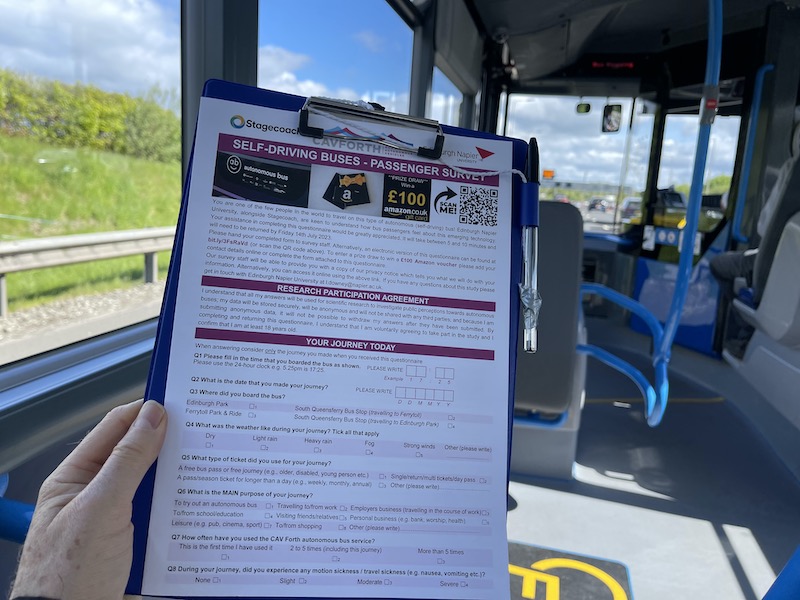
The drivers swapped roles from Captain (in the bus) to Safety Driver (in the cab) and the bus was brought around the turning circle in manual mode (autonomous would have been fun) to the boarding bus stop …
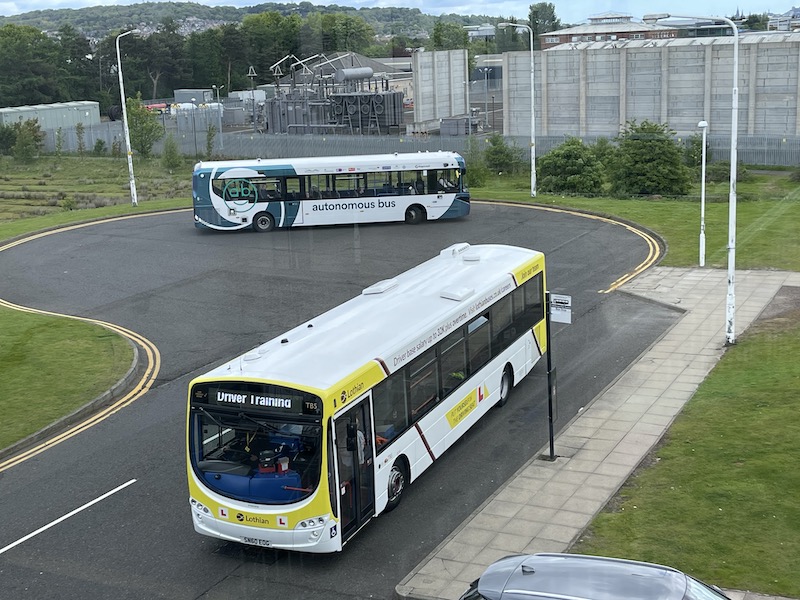
— which I noticed had no reference to the new route in its timetable case, which seemed a missed opportunity.

Simon, Safety Driver, ushered the half dozen of us on board and Angela greeted us with an instruction we must wear seat belts then sold us tickets from her hand held contactless enabled ticket machine as Simon drove off, still in manual mode.

The bus interior is to a standard Stagecoach Enviro200 layout including the usual add-ons such as both usb and wire free charging but no next stop announcements or displays.
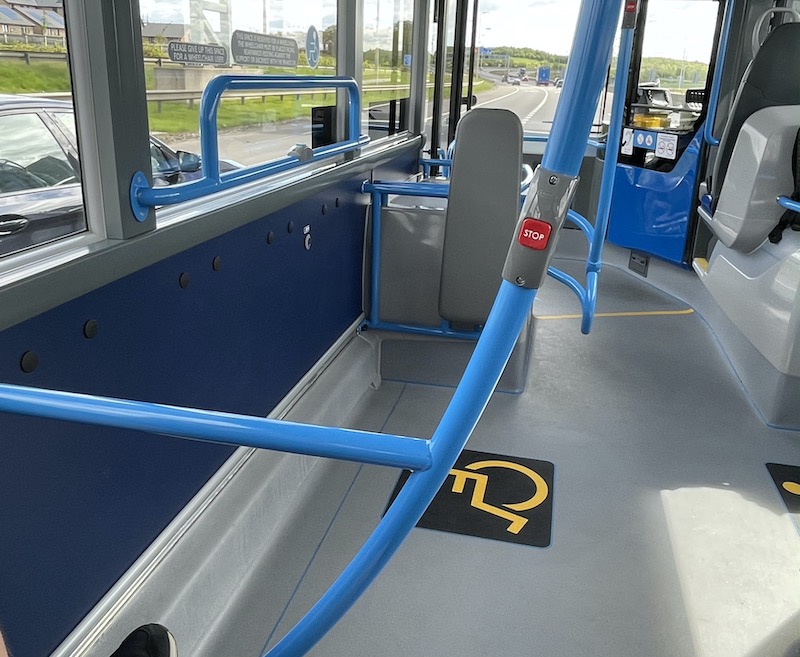
Once tickets had been sold Angela was very helpful in explaining what was happening and urging us to listen out for the buzzer indicating we were transferring to autonomous driving mode. She said her preferred positioning in the cab is to keep her hands close to the steering wheel in case of needing to intervene rather than doing any hallelujah style chorus waving.

The buzzer sounded as we hit the M90 and autonomous mode was enacted.

For most of the journey we were following an autonomous bus with a driver under training but when other traffic cut in between us it made no difference if they were going faster but when they started braking it caused us to brake a couple of times and was definitely harsher than a human driver would have done.
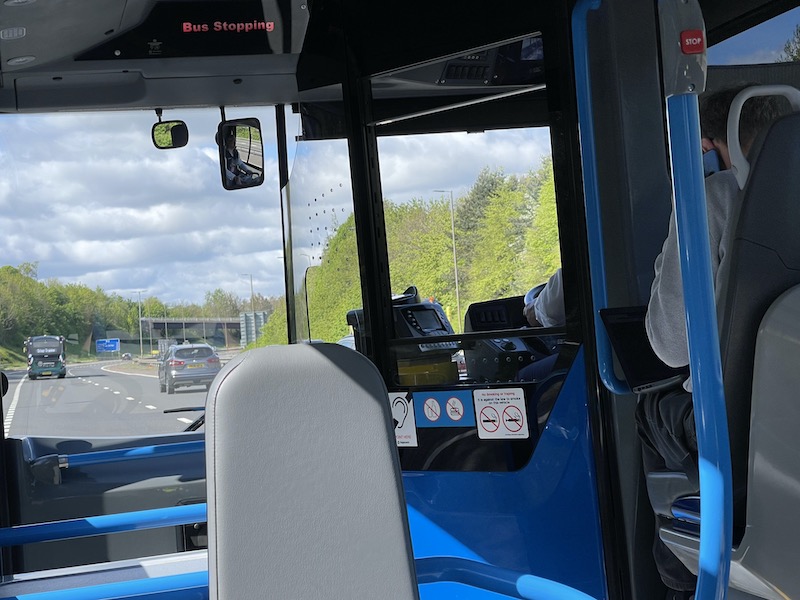
Angela said her favourite section of route us the acute 60 degree left hand curve as the M90 becomes the A90 and experiencing the bus automatically following round the curve.
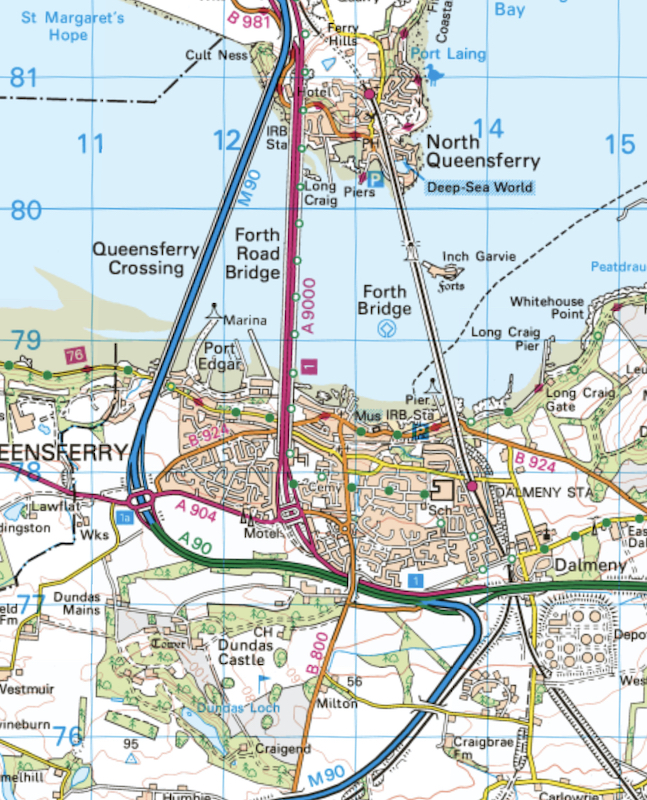
We came off the M90 at junction 1A and made our way the short distance on the A904 to the bus only (and original) Forth Road Bridge back in manual mode. And Angela explained the autonomous mode wasn’t being used over the Bridge for now which was a shame.

We soon arrived at the Ferrytoll Park & Ride site where there’s a bespoke shelter for the new service …
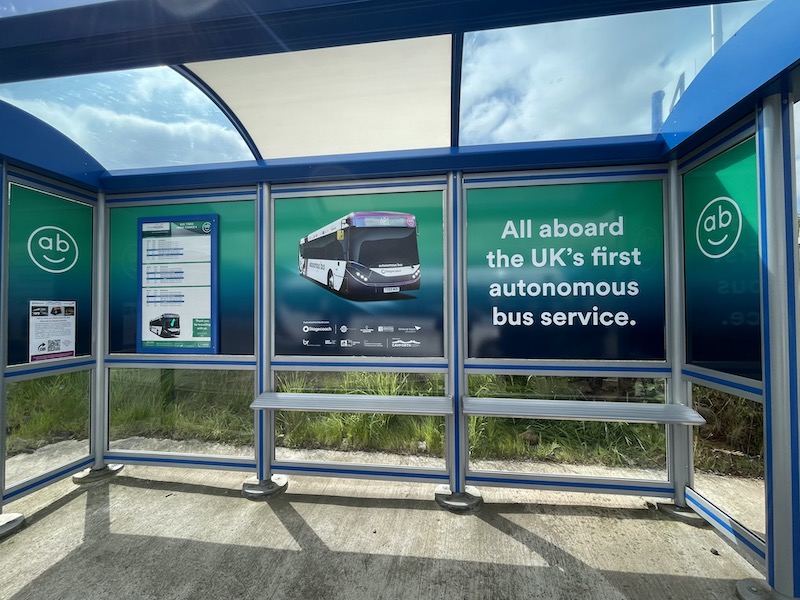
…. and a dozen passengers waiting for our 11:00 departure once Angela and Simon had swapped roles again.
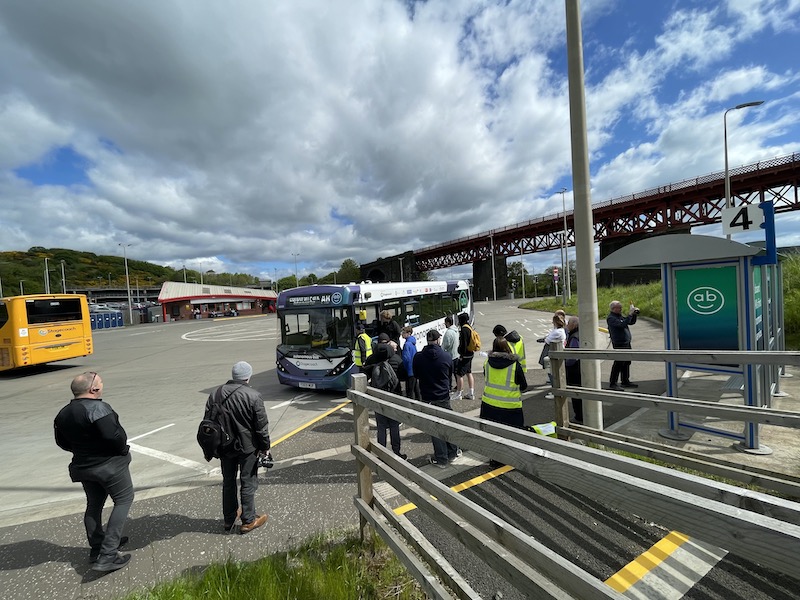
I met Roy there who’s a regular blog reader and who kindly picked up a leaflet for me about the new service from the building that houses a waiting area for passengers.
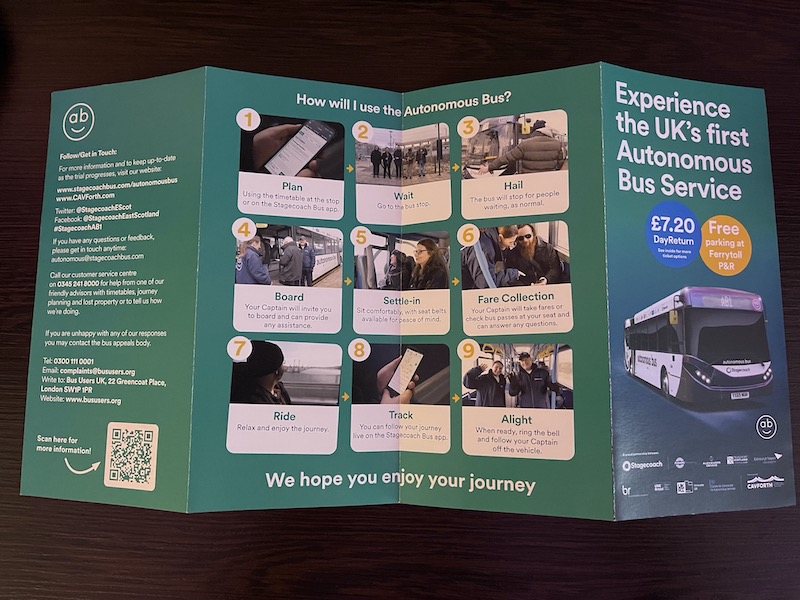
As well as details of the AB1 service (times and fares) the leaflet explains “autonomous vehicles … offer … safer, greener roads to better customer experience … improved access through lower operating costs”.
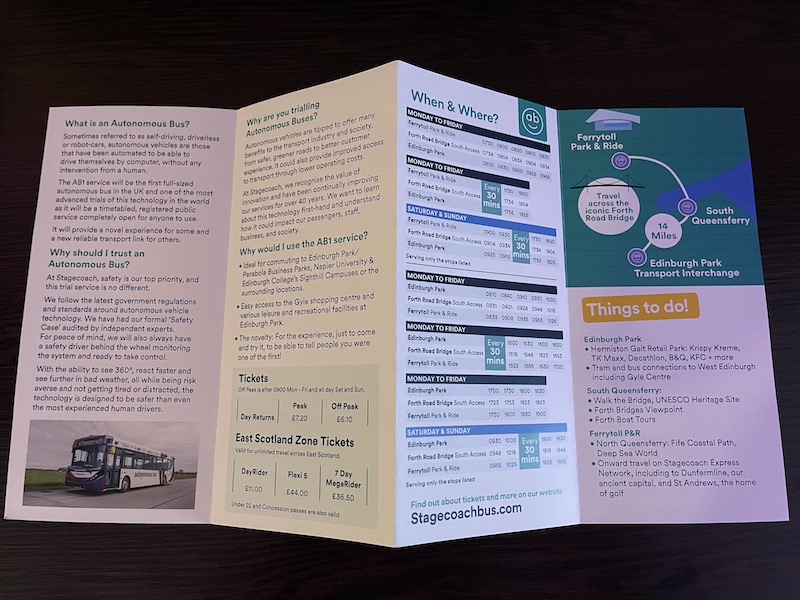
Well, certainly not lower costs in the short term with both Angela and Simon needed and the technology can’t have come cheap with the last estimate I saw putting a £6.1 million price tag on CAVForth. With route AB1’s trial now set to last two years instead of the original six months it looks as though more project funding has been awarded.

As Angela drove, Simon looked after us on the return journey answering questions and giving a running commentary not least when harsh braking indicated the bus had picked up an update from Transport Scotland that the bus lane we’d been using on the M90 was closed ahead, confirmed by signs, necessitating avoiding action to change lanes which I wasn’t sure was the bus performing automatically or more likely Angela intervening.

I can’t say the braking was enacted in “a safer, greener” way nor was it “a better customer experience” than if Angela had carried out the manoeuvre herself having seen the signs ahead.
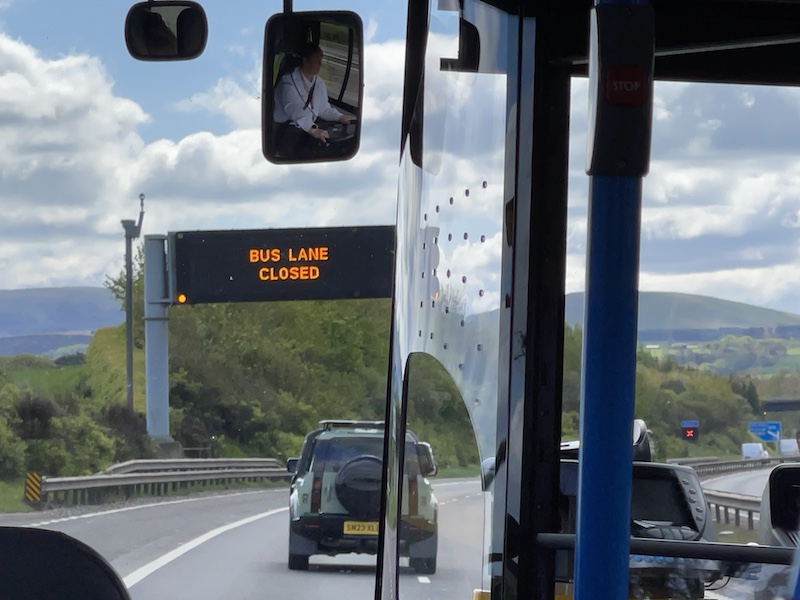
But maybe this harshness can be excused by it being only day one of the public trial …. except this project has been trialling since September 2020 (at least) so it’s a bit surprising such harsh braking is still a feature.
Roy made the point that Edinburgh Park is a bit if an odd southern terminal point for new route AB1. He’s right, as I can’t imagine many people parking at Ferrytoll then getting the AB1 to Edinburgh Park – as Roy suggested, a better penetration of the nearby Business Park would have made more sense as well as serving retailers at the Gyle Centre.
But I guess the main patronage for the new route is going to be curious passengers like me, Roy and everyone else who were travelling yesterday … and today and tomorrow and probably every day for the next two years.
And then what?

Roger French
Blogging timetable: 06:00 TThS

Such an incredible waste of time, money and resources. Makes a DRT scheme look feasible!
LikeLiked by 4 people
If we have a bunch of elderly at one side and young children on the other side which does the AI hit ?? Human instinct is to miss both
LikeLike
We spent so much time wondering whether we could, we didn’t stop to think about whether we should.
Why not have the safety driver sell tickets, and save on crew?
How long do you they anticipate before the bus is able to drive itself asking the whole route? If “never”, what’s the point of it all?
LikeLike
I have always thought it would be far more sensible to be developing autonomous trains. The cost savings are greater and a train operates in a pretty controlled environment unlike a bus
I do not real see how they can claim this bus is a world first
If the technology works why is the bus being driven manually for a lot of the journey?
One thing I have never seen in these trials is how they handle safety with passengers getting on and off the bus this never seems to have been tested
On this trial was the bus in autonomous mode at bus stops including opening and closing the doors?
Does this autonomous bus know if a wheelchair user wants to get on or off?
How do you buy a ticket on an autonomous bus and how does it know passengers boarding with a pre pay ticket have one ?
What happens if someone boards without a ticket ?
They are going to burn through cash pretty fast with a crew of two on board
LikeLike
In what way are the ‘roads greener’? Come to that, how is better customer (passenger) experience improved if the braking is so sharp?
What I have never understood is how an autonomous vehicle, given the choice of running someone over who has run in front of the vehicle or smashing into parked vehicles or knocking over pedestrians on a pavement, which option would it choose?
LikeLiked by 1 person
They have sensor’s so the bus would break to try to avoid the pedestrian and or swerve depending on what the safest manoeuvre is.
With a driver the first reaction is probably to brake and if the breaking instance is too short to swerve as well. An autonomous vehicle can react faster than a manually driven vehicle
Autonomous Fork lifts are no widely used in warehouses
It does depend on how well the software has been written the algorithms will be complex
I think it would be far more sensible to focus on autonomous trains as they operate in a well controlled environment
LikeLike
A driver will react instinctively to a sudden crisis. Remember the double-decker incident in Somerset on an icy road? The bus was overtaken by a motorcyclist who then fell off; the bus driver swerved to avoid him; and the bus ended up on its side as a write-off. If something similar happened with an autonomous vehicle the concept would be negatively impacted, as they say.
That effect is demonstrated on the Cambridge Busway where errant pedestrians and cyclists have been hit by buses, prompting speed limits and carriageway closures to protect them.
LikeLiked by 1 person
What do you mean by “autonomous trains”? The Victoria Line has had automatic trains since 1968, with a driver merely to close the doors and ensure safety. The DLR has never had drivers, and there are many such systems around the world. Street-running trams (not on reserved track) would be a different proposition though!
LikeLiked by 1 person
There are only two driverless train lines that I am aware of in the UK. They are the Docklands Railway and the short line from Luton Station to Luton Airport
The Paris Metro Metro has two driverless Lines with a third being converted
The Elizebeth line at least in theory could be driverless over the Central section
LikeLiked by 1 person
I saw driverless buses in Australia four years ago.
LikeLike
I think that autonomous vehicles are overhyped vapourware. This particular route has few stops and dedicated busways for much of its run. I just don’t see autonomous vehicles ever being mainstream – they don’t mix well with non-autonomous vehicles and typically require to be separated from general traffic or to have their own infrastructure. I think it’s clear from this review – and from another review I’ve seen of this route – that there is no chance of the ‘driver’ being removed ever on what is perhaps the most suitable AV bus route in Scotland. We’re saving part of one salary for each bus at the cost of much more expensive buses and infrastructure to enable this!
At a time when we are facing an environmental crisis, I’d prefer that the money was spent on tried and tested public transport solutions like trams, railways and humble conventional buses. This route is small beer in terms of its costs but if AVs are ever to become more than a niche solution for things like transport at airport carparks or between airport terminals, they will need a tsunami of money to do something which is frankly pointless and counterproductive in the first place.
We could probably bring back trams in every city that had ever had them, fully reverse Beeching and build HS3 and 4 with the kind of money we’re talking about!
LikeLiked by 3 people
One, I would never travel on an autonomous bus, and two, especially one travelling over a large body of water!
LikeLike
Talking of hype, LNER is trying to celebrate 100 years of operating services on the ECML! Never mind the period of nationalisation, or the various other TOCs who ran it.
https://www.bbc.co.uk/news/articles/cg3dzzwp41yo
LikeLike
In spite of all the hype and fluff . . . this is a trial to prove the concept. If the concept IS proven (which is not certain), the next stage will be to extend the trial to bring in more challenging environments. It will only take one fatal (or serious) accident to bring the trial to a shuddering halt.
ISTR that there were autonomous cars on trial in California? ISTR also that there was a fatality because the car couldn’t distinguish between light and shade and acted incorrectly. That trial ceased, and I haven’t seen or heard of any continuation. {I am happy to be corrected}.
Not unlike DRT . . . it is necessary to go through the process before concluding that something is wrong. We all know that DRT is unlikely to ever cover costs of operation, but maybe that’s not the point . . . if it halts the decline in passenger numbers, maybe it’ll have been worth it . . . but we have to go through the process.
As Julian Peddle recently said (and boy, do I agree with him!) . . . with all the best research and planning in the world, sometimes new route ideas simply don’t catch on. If they don’t, learn from the failure and move along . . . but at least make the attempt.
LikeLiked by 1 person
Hello! All aboard This is a very informative blog. Enjoy the ride. Have a safe trip. Keep going and enjoy. Have a great day.
LikeLike
Copenhagen has a fully automatic unstaffed Metro and the plan is to upgrade the S Tog surbuban trains to fully automatic in the future. Also most stations are devoid of staff with only ticket machines, the country is also largely cashless, infact we managed everything just on credit cards, we only used the buses with a day travelcard as it appeared impossible to buy a ticket on the bus with a card.
LikeLiked by 1 person
Roger, another fascinating blog. Both the DLR and Londons Victoria and Jubilee lines still have a human on board in case things go wrong. It’s clear neither Simon or Angela trust the technology even though they are still ‘In the driving seat’ in case of a problem. So it’s not a real test as humans are still in control. If it was truly driverless wait until the first one breaks down in the middle of the Forth Road bridge, what would happen then? And heaven forbid there is an accident with another vehicle, exchanging insurance details would be interesting?
Where this technology might be useful is moving buses around in depots at night when they are being fuelled, washed and cleaned.
What also baffles me is how the bus will know when to start it’s journey? In a car there will always be a passenger the initiate movement. But on a bus, who will be in control? It’s ok when it’s on time but what happens when unpredictable traffic congestion or roadworks make it run late?
This is a ‘toys for geeks project’
LikeLiked by 2 people
Many thanks for this fascinating review.
When I rode on a Navya autonomous minibus around the semi pedestrianised town centre of Sion, Switzerland seven years ago, frequent harsh braking was the most notable feature, particularly when pedestrians walked anywhere near the vehicle. I am amazed this is still a problem. Crossing pedestrians may also similarly affect the buses at terminals, if autonomous mode is actually used there.
It all reminds me of the scene in the film “The Sound Barrier” (1948) where Ralph Richardson, on being accused by his daughter of being responsible for the deaths of her husband and brother, thanks to his obsession with supersonic flight (“Who needs to get to New York in two hours?”) replies “but if we don’t do it, somebody else will”!
LikeLike
£2 Fare and BRG extended
The £2 fare is extended to October and after that goes to £2.50 until November 2024, BRG i also being extended
I would have though it would have been better to have a simple zonal fare rather than a flat £2
Say £2 0 to 5 Miles
£3 5 to 10 miles
£4 Over 10 miles
Another thing that could be changed is the free school travel scheme. It currently costs well over £1B a year
It could be changed so that the first 2 miles(Primary Schools) and First 3 miles (Secondary schools) has to be paid for with the councils only covering any actual cost difference
Councils as well should only cover the fare to the nearest school. Councils should not fund travel to a religious school
Exceptions would be for those with disabilities
LikeLike
Breakdown of new funding
£300M to protect services over the next 2 year
£160M to improve fares services and infrastructure.
£140M directly to the operators
£200M to BFCG
It seems a bit confusing at to what these various funding streams are for as some seem to duplicate others
Total funding is £500M
LikeLike
Picking up on something tangential Roger wrote, I find it extraordinary that Stagecoach still don’t think next-stop displays in any way important. Brighton & Hove were specifying the equipment 20 years ago!
LikeLiked by 1 person
Hulleys to launch Peak District open top service.
https://www.derbyshiretimes.co.uk/news/transport/new-open-top-bus-route-introduced-for-peak-district-perfect-for-sightseeing-around-picturesque-villages-and-countryside-4146016
LikeLike
This and DRT only show how in thrall authorities are to “new technology” whatever it costs. It’s only a few years later that reality kicks in! Leicester’s HOP is another example of wasteful use of government funding, a clockwise route would serve the traffic objectives better, but it would be a longer journey thanks to local authority one way road schemes and that would need more money. Designed down to a price rather than as a user friendly service. Dennis Hemsley
LikeLike
The HOP! is proving pretty successful (daily loadings well north of 500 per day now) and achieving the intended purpose of its introduction, whether it can continue as a free bus once the current allocated funding is a question but that is seperate from whether it is a waste of funding as, unlike many DRT schemes, it isn’t expected to go commercial and has specific purposes not related to financial performance. There was a detailed discussion of routing before launch, a clockwise route would serve St Margaret’s Bus Station better but not be able to serve the Market/Town Hall area nor the Railway Station as well, nothing to do with ‘one way schemes’ but due to the location of the Railway Station on a complicated junction meaning there is no safe place for a bus stop on the clockwise which can be done on the anti-clockwise (the outbound stops are south of the junction on London Road whilst the inbound stops are north of the junction on the inner ring so can be served by a bus on the inner ring). The clockwise route was never expected to serve the station, it was considered for after the redevelopment of the station when a change in layout may allow a bus to turn outside but it wouldn’t have had a stop anywhere near the station if running this direction. The one way scheme issue is what prevents the anti-clockwise from getting closer to St Margaret’s but it gets pretty close, it is about as close to the pedestrian entrance of SMBS as it is to the pedestrian entrance of the station and the walk is no more than walking the length of Haymarket Bus Station, and can be clearly seen from the stop.
LikeLike
The fact that seat belts are required to be used, shows the lack of confidence in the safety of the system, and especially the sharp breaking. Use of seatbelts is not usually required on a localbus service, is this not registered ??
LikeLike
These buses were new in 2019 hence the 69 reg plates – stored since then due to COVID. Originally 26326 – 30 – now 62001 – 5 in Stagecoach fleet
One was used at Stagecoach Manchester’s Sharston depot for trials around the depot https://www.flickr.com/photos/ps_bus_driver/48063615397
UK’s first full-sized autonomous bus begins depot trials – Stagecoach Group
https://m.stagecoachgroup.com/media/news-releases/2019/2019-03-18.aspx
LikeLike